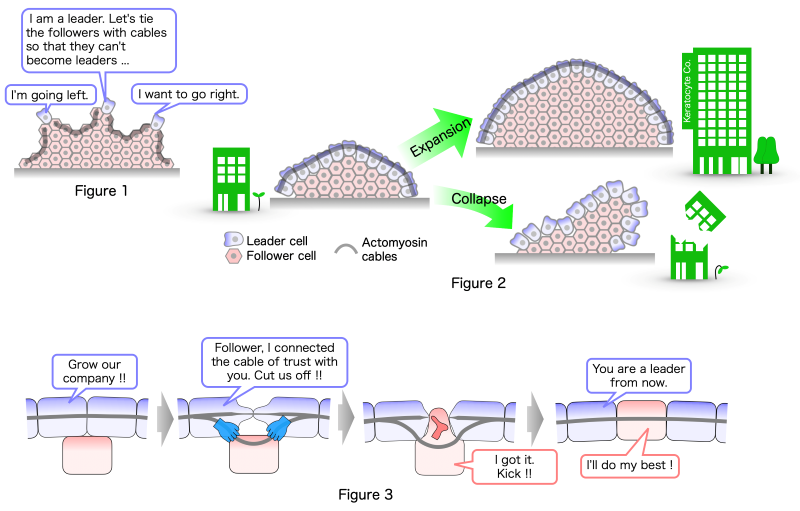Collective migration of fish epidermal keratocytes like a rapid growth of a good standing company that cares about its employees!
– The speed of fish wounds repairing is 50 times faster than human skin.
Research fellow OKIMURA Chika, Graduate Student IWANAGA Misaki, and Prof. IWADATE Yoshiaki (Biophysics Lab., Dept. Biology, Yamaguchi Univ.) in collaboration with Prof. SAKURAI Tatsunari (Musashino Univ.), Assist. Prof. UENO Tasuku, and Prof. URANO Yasuteru (The Univ. Tokyo) discovered unique competitive and cooperative behaviors of cell collectives involved in repairing wounds in fish.
When a single fish scale is adhered to a cover glass, epithelial cells called keratocytes, crawl out from the scale as a sheet with semi-circular shape and initiate wound repair. At the leading edge of the sheet, the leader cells are connected each other via actomyosin cables. They pull follower cells to advance the sheet. While the size of individual cells never change, the sheet expands remaining its semi-circular shape. This is impossible unless the arrangement of cells continues to be strictly optimized. This unique collective migration mechanism may be the key to fast wound repair in fish. The research group has clarified one aspect of this mechanism. In general human or other epithelial cell collectives, it is known that each single leader cell pulls the collective independently (Figure 1). However, interestingly, the leader cells in keratocyte collectives connect to each other with cables to maintain the shape of the collective (Figure 2). The collective expands by having the cable cut by subsequent single follower cells, and the follower cells are connected by new cables to promote them to leaders (Figure 3).

This mechanism is reminiscent of the rapid growth of a good standing company that cares about its employees. There are no selfish bosses in keratocyte collectives. The leaders promote competent followers one after another. It is exciting to think that this unique mechanism could be medically applied to humans and that in the near future, wounds will cleanly heal in the blink of an eye. The results of this research were published in Proc. Natl. Acad. Sci. U.S.A. on April 27, 2022.
Background
Although cuts, grazes, burns, and other “wounds” rarely cause death, the pain and inconvenience of living with them until they heal, as well as the cosmetic demand to avoid leaving scars, have made the development of treatments for these wounds as desirable as a cure for the common cold. Wounds heal by the natural healing ability of epithelial cells that migrate to the damaged area and fill the wound; it is important to understand the migration mechanism of cell collectives in order to develop effective treatments. Wound healing in fish is known to be tens of times faster than that in humans.
Research Points
- In general human or other epithelial cell collectives, it is known that each single leader cell pulls the collective independently (Figure 1). Subsequent follower cells are connected to each other by cables and promotion to leadership is suppressed.
- In keratocyte collectives, cables connect the leader cells and maintain the shape of the collective (Figure 2).
- Additionally, the leader cells expand the collective by having the cables connecting them cut by subsequent follower cells, then new cables connect to the followers and they are promoted to leaders (Figure 3).
Published Thesis Information
- Title: Leading edge elongation by follower cell interruption in advancing epithelial cell sheets
- Authors: Chika Okimura (Yamaguchi Univ.), Misaki Iwanaga (Yamaguchi Univ.), Tatsunari Sakurai (Musashino Univ.), Tasuku Ueno (The Univ. Tokyo), Yasuteru Urano (The Univ. Tokyo), Yoshiaki Iwadate (Yamaguchi Univ.)
- Publication: Proc. Natl. Acad. Sci. U.S.A. (2022)
- D O I: 10.1073 / pnas.2119903119
- URL: https://doi.org/10.1073/pnas.2119903119